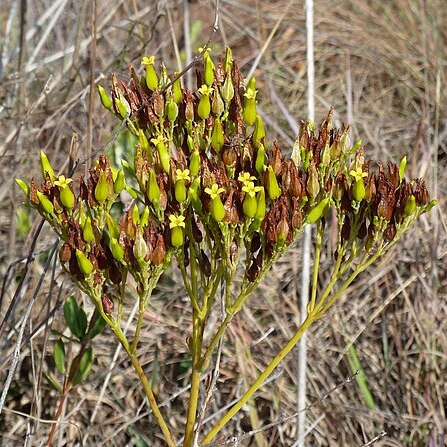Corolla 11·5-14 mm. long; corolla-tube ±11 mm. long, broader (c. 3 mm. in diam.) near the base, distinctly 4-angled, the angles with a raised subrigid nerve at maturity prolonged along the lobes, narrowing successively towards the base of the limb and contracted there, yellow-green; corolla-lobes (2)2·5-3 x 1·5-2 mm., ovate, acute, apiculate, yellow-green or yellow outside, yellow or orange-yellow on the inner surface, erect but not connivent, finally reflexed or subreflexed.
Lower subrosulate leaves very large, up to 24.5 cm. long (including the flat, up to 5 cm. long subpetiolar base) and 16 cm. broad, subcircular, broadly obovate or ovate-spathulate, rounded at the apex, attenuate or contracted below; cauline leaves decussate, in 2-4 pairs, smaller (the uppermost bract-like), oblong-ovate, sessile, decurrent, all entire, ± conduplicate (the lamina folded upwards), arched-reflexed, rather fleshy, rigid-coriaceous on drying.
Succulent shrublet, rosettes developing a single, erect stem, up to ± 1.2 m high. Leaves sessile at base, higher up almost petiolate, ovate, oblong flattened, 100-160 x 60100 mm, obtuse or rounded, entire, folded lengthwise. Inflorescence a flat-topped thyrse with many, loose dichasia ending in monochasia. Corolla yellowish green; tube quadrangular-cylindrical, 11-13 mm long; lobes deep yellow. Flowering time Mar.-July.
Perennial herb, up to 1.2 m high; single stemmed from base; glabrous. Leaves petiolate to sessile; blade ovate to almost orbicular, 100-160 x 60-100 mm, apex obtuse or rounded, base ± cuneate, margin entire, tinged red, folded lengthwise. Flowers: inflorescence a flat-topped thyrse; calyx lobes triangular, 2-3 mm long; corolla with tube 11-13 mm long, yellowish green, lobes ovate 3-4 mm long, deep yellow; May-Sep.
Flowers uniformly reddish-brown on drying, in dense, several times trichotomous cymes, forming a flat-topped corymb-like terminal inflorescence up to 38 cm. (or more) long and 40 cm. in diameter; main branches stout, straight, suberect; pedicels 4-7 mm. long.
Stem 12-18 cm. long in the first year, with numerous subrosulate leaves, elongating in the second year into the floriferous stem with ± scattered leaves, stout, subquadrangular at the base, rigid, erect, simple.
Rosettes usually developing only 1 erect stem, up to 1.2 m high. Leaves petiolate, margin entire, base ± cuneate. Inflorescence a flat-topped thyrse. Flowers yellowish green and deep yellow.
Filaments 2·1 or 2·9 mm. long; anthers 0·75-1 mm. long, oblong, the lower ones below the sinus between the corolla-lobes, the upper ones slightly exserted.
Calyx green, rather shorter than the corolla; calyx-tube 1-2 mm. long; sepals 1-3·5 x 1·5-2·1 mm. deltate, acute.
A usually biennial completely glabrous succulent, up to 1·30 m. tall (incl. the inflorescence).
Scales 2-2·5 mm. long, lanceolate or linear-lanceolate, emarginate.
Follicles 8-9 mm. long; styles 1-1-5 mm. long.
Seeds c. 0·5-1 mm. long.

